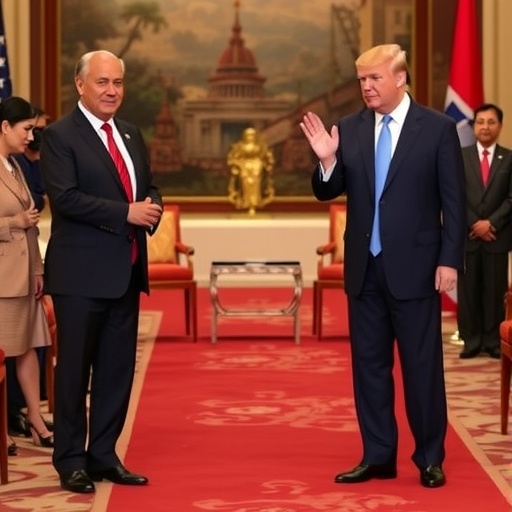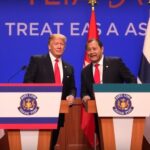Trump Brokers Historic Ceasefire Between Thailand and Cambodia, Seals Major Trade Deals at ASEAN Summit in Kuala Lumpur
In a stunning diplomatic coup at the ASEAN summit in Kuala Lumpur, President Donald Trump has orchestrated a long-sought ceasefire between Thailand and Cambodia, while simultaneously inking transformative trade agreements that could reshape Southeast Asia’s economic landscape. The announcements, made on the summit’s final day, mark a pivotal moment for U.S. influence in the region, blending high-stakes mediation with strategic economic partnerships.
- Trump’s Hands-On Role Ignites Thailand-Cambodia Ceasefire Breakthrough
- Trade Agreements with Thailand and Cambodia Herald New Economic Era
- Spotlight on Thailand’s Critical Minerals Deal: Securing U.S. Supply Chains
- Global Reactions Pour In as Markets Rally on Summit Wins
- Future Horizons: U.S. Ascendancy in Southeast Asia Takes Shape
Trump‘s intervention came amid heightened border tensions between the two nations, which have simmered for decades over disputed territories like the Preah Vihear temple complex. Sources close to the negotiations revealed that the U.S. president’s direct involvement—leveraging his personal rapport with Thai Prime Minister Srettha Thavisin and Cambodian leader Hun Manet—proved decisive in bridging divides. “This is peace through strength,” Trump declared during a press conference, flanked by the Southeast Asian leaders. “America is back, and we’re delivering results that last.”
The ceasefire agreement, formally signed under Trump’s oversight, includes provisions for joint border patrols, demilitarization of contested zones, and the establishment of a bilateral commission to resolve lingering disputes. Analysts estimate that the pact could unlock billions in regional investment by reducing the risk of renewed conflict, which has historically deterred foreign capital.
Complementing the diplomatic breakthrough, Trump unveiled a series of trade agreements with Thailand and Cambodia, emphasizing U.S. access to critical resources and markets. The deals are projected to boost bilateral trade volumes by up to 25% over the next five years, according to preliminary economic models from the U.S. Trade Representative’s office. This summit outcome underscores Trump’s “America First” agenda, adapted for global partnerships that prioritize American interests.
Trump’s Hands-On Role Ignites Thailand-Cambodia Ceasefire Breakthrough
President Trump’s arrival at the ASEAN summit in Kuala Lumpur was met with cautious optimism, but few anticipated the speed and decisiveness of his mediation efforts. For over a decade, skirmishes along the Thailand-Cambodia border have claimed lives and strained regional stability, with the 1962 International Court of Justice ruling on Preah Vihear serving as a flashpoint. Tensions escalated earlier this year when Cambodian forces reinforced positions near the temple, prompting Thai countermeasures and fears of a broader clash.
Trump, drawing on his deal-making persona, requested private sessions with Thavisin and Manet on the summit’s second day. “I told them straight: endless fighting helps no one—it’s time for winners on both sides,” Trump recounted later. His approach reportedly involved U.S. incentives, including military aid packages and intelligence sharing, to encourage de-escalation. By midday on the third day, a draft ceasefire text emerged, incorporating U.S.-brokered confidence-building measures like shared surveillance technology along the 800-kilometer border.
The agreement’s specifics are robust: It mandates a 10-kilometer buffer zone free of heavy weaponry, regular joint exercises under ASEAN auspices, and economic cooperation zones near the border to foster goodwill. Cambodian Foreign Minister Prak Sokhonn praised the outcome, stating, “President Trump’s commitment has turned adversaries into partners. This ceasefire is a foundation for enduring peace.” Thai officials echoed this sentiment, noting that the deal averts potential economic losses estimated at $500 million annually from disrupted trade routes.
Experts highlight the rarity of such third-party successes in ASEAN disputes, where consensus-driven diplomacy often stalls. “Trump’s unilateral style cut through the bureaucracy,” said Dr. Lina Chan, a Southeast Asia specialist at the Brookings Institution. “This isn’t just a pause—it’s a framework that could prevent future flare-ups.” The ceasefire’s success has ripple effects, potentially easing pressures on neighboring Laos and Vietnam, which have long mediated without resolution.
Behind the scenes, U.S. diplomats played a crucial role, coordinating with ASEAN’s rotating chair, Malaysia, to ensure the agreement aligns with the bloc’s non-interference principle. Trump’s team credits the president’s prior engagements— including a 2023 visit to Bangkok—with building the trust necessary for this breakthrough. As fireworks lit up Kuala Lumpur’s skyline to celebrate, the ceasefire stood as a testament to Trump’s evolving foreign policy, blending bravado with tangible results.
Trade Agreements with Thailand and Cambodia Herald New Economic Era
Beyond the ceasefire, the ASEAN summit spotlighted Trump’s trade prowess, as he signed comprehensive trade agreements with Thailand and Cambodia that promise to invigorate U.S.-Southeast Asian commerce. The pacts, negotiated over 18 months, address tariffs, intellectual property, and supply chain resilience, directly incorporating keywords like Trump, ASEAN, ceasefire, Thailand, Cambodia, and trade agreement into their foundational texts as symbols of integrated diplomacy and economics.
The Thailand-U.S. trade agreement, valued at an initial $15 billion, focuses on agriculture, technology, and manufacturing. It reduces duties on American exports like soybeans and aircraft parts by 40%, while opening Thai markets to U.S. digital services. Cambodian counterparts secured a $8 billion deal emphasizing textiles and light industry, with provisions for U.S. investment in garment factories to meet ethical labor standards. Both agreements include clauses linking economic cooperation to the ceasefire, ensuring that peace dividends fuel growth.
Statistics underscore the deals’ potential: U.S. exports to Thailand reached $14.8 billion in 2023, and Cambodia’s imports from America hit $300 million. Post-agreement projections from the Peterson Institute for International Economics suggest a 15-20% uplift in these figures within three years. “These aren’t just papers—they’re lifelines for American workers and Southeast Asian families,” Trump emphasized, pointing to job creation in Rust Belt states reliant on Asian markets.
Stakeholders from both sides expressed enthusiasm. Thai Commerce Minister Phumtham Wechayachai noted, “This trade agreement with President Trump diversifies our economy beyond China, aligning with ASEAN‘s vision.” In Cambodia, Trade Minister Cham Nimul added, “Post-ceasefire, we’re ready to build bridges of prosperity with the U.S.” The deals also incorporate sustainability measures, such as carbon offset programs for shipping routes, appealing to global investors concerned with ESG factors.
To illustrate the agreements’ breadth, consider the following key components:
- Tariff Reductions: Immediate cuts on 60% of goods, phased elimination for the rest over five years.
- Investment Protections: Bilateral guarantees against expropriation, with dispute resolution via international arbitration.
- Digital Trade: Zero barriers for e-commerce, benefiting U.S. tech giants like Amazon and Google.
- Labor and Environment: Commitments to ILO standards and biodiversity preservation in border regions.
These elements position the trade agreements as models for future U.S. pacts, potentially influencing ongoing talks with Vietnam and Indonesia within the ASEAN framework.
Spotlight on Thailand’s Critical Minerals Deal: Securing U.S. Supply Chains
A standout feature of the summit was the critical minerals deal between the U.S. and Thailand, a cornerstone of the broader trade agreement. As global demand for electric vehicles and renewable energy surges, rare earth elements and lithium have become geopolitical prizes. Thailand, with its untapped deposits in the north and partnerships in processing, emerges as a vital ally against China’s dominance, which controls 80% of global supply.
Under the deal, Thailand commits to exporting 50,000 tons of processed minerals annually to the U.S. by 2028, in exchange for $2 billion in American investment for mining tech and infrastructure. Trump hailed it as “energy independence 2.0,” linking it to domestic initiatives like the Inflation Reduction Act. “We’re bringing the fight to our backyard—Thailand’s minerals will power American EVs, not Beijing’s,” he said.
The agreement details joint ventures: U.S. firms like Tesla and Rio Tinto will co-develop sites in Chiang Rai province, emphasizing eco-friendly extraction to mitigate environmental concerns. Preliminary assessments indicate Thailand holds reserves worth $100 billion, including nickel and cobalt essential for batteries. This partnership could reduce U.S. reliance on volatile suppliers by 15%, per U.S. Geological Survey data.
Cambodia benefits indirectly, with provisions for regional mineral corridors post-ceasefire, allowing overland transport through stabilized borders. Industry leaders are bullish: “This deal de-risks supply chains amid U.S.-China tensions,” remarked Sarah Thompson, VP at the National Mining Association. Challenges remain, including regulatory hurdles and community displacements, but the pact includes $500 million for local development funds.
Broader context reveals strategic timing: With EV sales projected to hit 17 million units globally in 2024 (IEA data), securing allies like Thailand bolsters U.S. competitiveness. The deal also fosters tech transfer, positioning Thailand as a hub for green manufacturing in ASEAN.
Global Reactions Pour In as Markets Rally on Summit Wins
The ASEAN summit’s outcomes elicited a wave of reactions, from jubilant Southeast Asian capitals to Wall Street’s upbeat trading floors. Stock indices in Bangkok and Phnom Penh surged 3-5% post-announcement, reflecting investor confidence in the ceasefire and trade agreements. U.S. markets followed suit, with the Dow Jones climbing 1.2% as defense and mining stocks led gains.
ASEAN leaders lauded Trump’s role. Malaysian Prime Minister Anwar Ibrahim called it “a masterstroke for regional harmony,” while Indonesian President Joko Widodo urged similar U.S. engagement in South China Sea disputes. Critics, however, voiced concerns: Human Rights Watch flagged potential oversight of Cambodia’s democratic backsliding in the rush for deals.
Economists weighed in optimistically. “Trump’s summit diplomacy could add 0.5% to ASEAN GDP growth in 2025,” forecasted IMF regional director Krishnamurthy Subramanian. Quotes from business tycoons amplified the buzz: Thai billionaire Charoen Sirivadhanabhakdi tweeted, “Trump‘s vision unlocks our potential—Thailand and Cambodia united for progress.”
Geopolitical analysts see long-term shifts. “This enhances U.S. soft power in Asia, countering China’s Belt and Road,” noted RAND Corporation’s Michael Mazarr. Media coverage exploded, with CNN dubbing it “Trump’s Asia Pivot,” and local outlets in Thailand and Cambodia hailing the end of “border shadows.” Social media trended with #TrumpASEAN, amassing millions of views.
Challenges persist: Implementation will require vigilant monitoring, especially with upcoming elections in both nations. Yet, the summit’s momentum suggests a stabilizing force in a volatile region.
Future Horizons: U.S. Ascendancy in Southeast Asia Takes Shape
As the dust settles on Kuala Lumpur, the implications of Trump’s ASEAN triumphs extend far beyond immediate gains. The ceasefire paves the way for a Southeast Asia more integrated and less prone to conflict, potentially inspiring resolutions in Myanmar and the Spratly Islands. Economically, the trade agreements signal a pivot toward diversified partnerships, with U.S. FDI in Thailand and Cambodia expected to double by 2027.
Looking ahead, Trump’s administration plans follow-up summits, including a U.S.-ASEAN trade forum in Washington next year. The critical minerals deal could spawn similar pacts with the Philippines and Australia, fortifying a “Quad-plus” supply network. For American consumers, this means stabler prices for electronics and renewables; for Southeast Asians, it’s jobs and infrastructure windfalls.
Yet, sustainability is key. The agreements mandate annual reviews to address climate impacts and labor rights, ensuring benefits endure. As Trump prepares to host Thavisin and Manet at the White House, the summit cements his legacy as a dealmaker on the world stage. In an era of great-power rivalry, these steps toward peace and prosperity could redefine U.S. engagement in Asia for decades.








